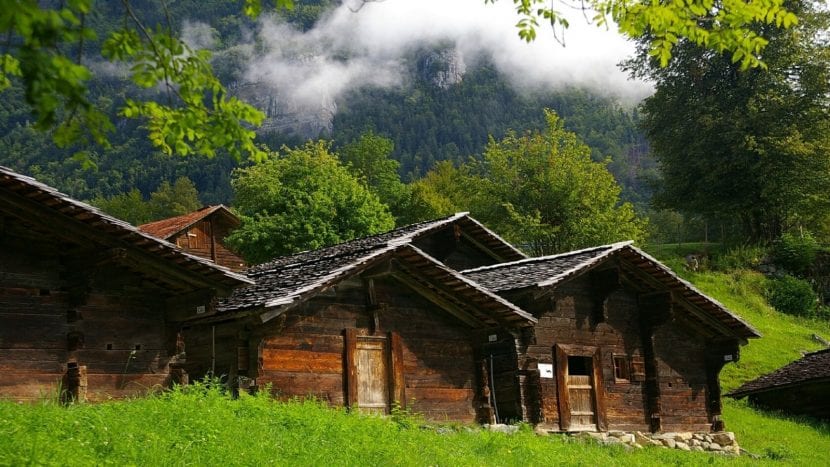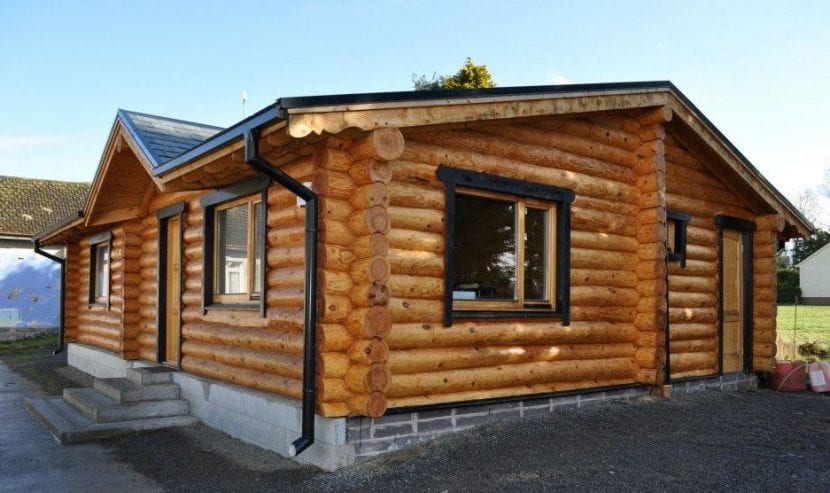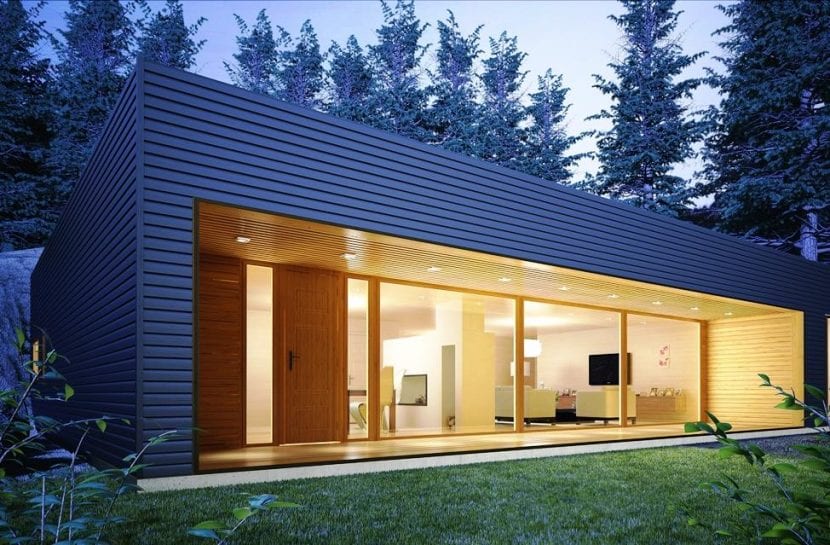
The wooden house sector has grown considerably in the last decade and is that its competitive prices and the shorter construction period makes many of us interested in this type of housing.
To be more exact the wooden houses are around 25-30% cheaper that a concrete house and in terms of construction should not be suppose more than 5 or 6 months.
This is why many people begin to choose them for a second residence and later as a home for the whole year.
If you want a wooden house not only do you have to look at price and make it as beautiful as possible, to this day there are many types and aspects to consider to have the house "almost perfect" and I say almost perfect because there is nothing perfect in this life.
Equally, You can purchase the purchase through 3 modalities:
- Buying only the Kit (equipment) and assemble it yourself.
- Buying the assembled kit
- Buying the house turnkey, completely finished.
On the other hand, the first thing you should know is that at least in Spain to build a wooden house You will need the building permit from the City Council and an architect project.
To make sure the houses built comply with the CTE, known as the Technical Building Code.
Types of wooden houses.
There are three types of wooden house constructions, each with its advantages and disadvantages.
Of logs.
The first of all is logs.
This kind of house it is built or mounted directly on the plot using logs thus giving it that characteristic touch.
This type of house has the advantage of wood thickness, with this I mean that thanks to the dimensions of the wood we have a excellent temperature and humidity regulator inside the house having quality in winter and cool in summer, which in the end is what matters.
The problem or disadvantage of this type is the imperfection of the union between one trunk and another, although it could be solved by using square logs that fit better than round ones.

Lightly woven.
Are used standardized panels and parts that greatly simplify assembly, plus a large number of small elements help the modulation, prefabrication and interchangeability.

Heavy woven.
At first glance, the difference between light and heavy framework is the size of the beams or the pieces of wood used, but this is not the case.
In heavy webbing avoids the use of steel-based joints and nails and the assemblies or unions that take advantage of the tension of the structure are used more.
In addition, allows the construction of multi-storey buildings, something that with the light framework can lose stability from 3 heights.

Mobile phones.
They can be both wood as in other types of coatings.
They are houses already assembled at the factory and transported in several pieces or even in one, depending on the final size of the house, up to the final location.
This type of wooden house is usually the most common in central and northern Europe.
In Spain, as it is not yet a normal option, builders are willing to promote them until they get it.
In fact, there is the Association of Manufacturers and Builders of Wooden Houses with main objectives, on the one hand, that of negotiate with insurers to avoid penalties and on the other hand, offer information on the advantages of this type of housing in a general way, whether to citizens, architects or the builders themselves.

Where does the wood come from?
As is logical to think, wood is a product that is marketed and as such has several ranges or quality, going from the most optimal to the most acceptable.
All of them are wooden houses with just the kit
- High quality- Made in Finland, the United States, Canada, Denmark, Norway and Sweden.
- Medium quality: made in Latvia, France, Poland and Spain.
- Standard Quality: made in Chile, Brazil, Lithuania, Estonia and Romania.
In order to have this classification of the different qualities are taken into count some parameters as they are:
- The guarantee that the wood has been dried. Thus avoiding deformations, rotting among other problems.
- Calculation of loads. It refers to the loads that the walls and ceilings can withstand.
- Technology. The most valued is the control number of each Kit piece.
- Measurements and thicknesses of the wood sheets. Optimum thickness of 90mm plus the insulation chamber of at least 50mm plus the inner lining.
- Anti-humidity and protective treatments. Insecticides and fungicides.
- Certificates. Related to Responsible Forest Management (FSC and PEFC) and the CE certificate.
- Quality of materials. The most valued wood is from high mountains and slow-growing trees.
Sorry to say that in Spain if you want a wooden house it would have to be quality / standard range since the wood comes from the pines of the Romanian Carpathians even having failures in the organization, supply of the Kits and in the delivery times.
If the wood from Spain is mid-range, why is it ordering wood from Romania that is of standard quality?
Surely you have asked yourself that question and the reason is easy to see, although I personally do not like it.
It is because Most of the distributors in Spain work with this wood because they have the most competitive prices.
How to choose the “perfect” log house
I have already commented that we cannot choose or have the perfect house but we can get closer to that state.
The best and even the most used are those of light lattice which can also be known as American houses, Canadian houses or timber frame (wooden frame).
A wooden house of the type light fabric has a durability of more than 75 years, that is to say that it is greater than solid wood houses and even exceeds brick or concrete structures.
In addition, these houses they achieve an enormous balance between the thermal, steam and breathing insulation of the walls.
Which means an improvement in living conditions inside the home.

The basic elements.
The basic elements that make up a light frame house are 4: roof, forged (separation between floors), interior walls and exterior walls.
Outer wall has:
- Casing beams 45x145mm
- Decorative material (wooden platform for example)
- Strut 25x45mm
- Windproof membrane
- Chipboard or OSB
- Insulation 150mm
- Vapor counter membrane
- 12,5mm plasterboard
Inner wall with:
- 12,5mm plasterboard
- Insulation 100-150mm
- Vapor counter membrane
- OSB or plasterboard 12,5mm
- Casing beams 45x145mm
The separation between the floors or the wrought has to have:
- Pallet flooring
- Windproof membrane
- Insulation 150mm
- Vapor counter membrane
- OSB or plasterboard 12,5mm
- Casing beams 45x145mm
And finally the roof with:
- Roof (tégola, tile)
- Anti-humidity membrane
- Air chamber
- Strut 30x100mm
- Insulation 150mm
- Vapor counter membrane
- Structure beams 50x20mm
- 12mm plasterboard
The ideal of light frame houses is to have a strong and solid structure in whose spaces you can put walls, which also have a structure of wooden slats that form frames (which is why they are known as timber frame) and between them the interior and exterior finishes are fixed, as well as other elements.
Likewise, One of the advantages of this type of wooden houses is that it is possible give you the finishes that we like the most by its same structure, either inside or outside (facade), being different or equal on both sides.
On the other hand, another advantage of the lightweight fabric is that houses built are cheaper, at least in theory, than the other types of houses since they have less wood since the walls they are from OSB or other items.
What is an OSB wall or finish?
OSB are the abbreviations for Oriented Strand Board, translated as oriented chip board and it is a kind of conglomerate board.
This board constitutes the evolution of plywood boards, in which instead of joining several sheets or veneers of wood, several layers formed by wood chips or shavings are joined, oriented yes, in the same direction.
The possible finishes that we can incorporate.
I have already mentioned previously that you can choose the same finish or even several for the interior of the house or for the exterior but do you know which there are?
Well here you can see 8 types of finishes to select which are:
- OSB boards, previously explained (they are a current trend)
- canaxel, this coating is made of high-density wood chips, which offers the aesthetics and robustness of colored wood without its natural imperfections.
- Exposed brick.
- Artificial stone, it could be placed as a plinth and is the cheapest.
- Natural stone, it is usually put as something specific detail because its price has increased.
- Wood tongue and groove, special for outdoors.
- Monolayer, this finish is nothing more than a special mortar with an appearance equal to cement. It is quite expensive and there are already some copies like the cement and glue mixture.
- Ecological mortarsThey are made with natural materials such as lime, clay ...
Legal aspects of wooden houses in Spain.
Some people believe that log houses or prefabricated houses do not have to adhere to planning licenses and this is not the case.
You have to know that the wooden houses once they are on the ground or rather "anchored" to the ground, in a part of the ground ready to be used, to be considered real estate and as such, they are subject to common urban legislation.
They can also be enrolled in the Property Registry once they are installed.
However, prefabricated or mobile wooden houses that are not "anchored" to the ground by construction, that is, they can be separated, disassembled or changed their location, they are considered movable property.
For this very reason, must meet the NBE, the Basic Building Regulations and respect the regulations of the land on which they are installed.
So always you must take into account the type of soil in which you install your house, if it is developable land, undeveloped land, urban or rustic.
Elements or Regulations to take into account.
For wood houses, considered as property must take into account 3 Regulations fundamental that are: Basic Building Standards (like mobile homes), the Building Planning Law (LOE) and the Technical building Code (ECT),
Basic Building Standards (NBE).
They refer to the defense and security of people, establishing the minimum conditions to meet human needs and also protect the economy of society.
The Building Planning Law (LOE).
Perhaps it is the Building Law that sounds the most to you and is in force in Spain since 1999.
This Law deals with basic aspects in the building process at the same time that it determines the obligations of the building agents, as well as their competences and the fields of application.
Technical Building Code (CTE).
As I indicated at the beginning of the article, to confirm that the houses comply with the CTE, you will need an architect project and the construction permit from the relevant City Council.
The CTE refers to main set of regulations governing the construction of buildings in Spain since 2006.
Thus establishing the basic requirements for safety and habitability of buildings.
Advantages and disadvantages of wooden houses
Finally, that it was about time, let's move on to the interesting, the advantages and disadvantages of the houses that you have heard / read so much about.
It seems that in Spain the fashion for this type of house is increasing but we still do not know what to really expect.
For this I am going to give a series of brushstrokes on the positive and negative points that they can have this type of house.
Advantages or positive points.
Timber, the main building material, is a natural insulator that can protect us from bad weather.
Moreover, resists wear well produced by the Sun, wind or humidity so its durability she's very tall.
With the above (natural insulation) I add that there is nothing better than having your house warm in winter and cool in summer, an advantage that is also related to the consequent energy saving.
In addition, wood has a great mechanical resistance, which does not prevent it from being a solid material capable of offering protection.
There are new solutions in case of fire and it is that, with the new treatments with flame retardant substances, the combustion is not so fast adding that the wood is already a stable material with respect to the fire, I mean by this that it burns slowly.
Not being the case of a building made of bricks, cement and concrete.
Leaving the material itself (wood), it remains to say that it is very versatile and can be adapted to any design of houses and can be fully customized.
Regarding its construction, it should be noted that it is a sustainable, cheap and fast construction.
Sustainable because it is a clean construction, which consumes little water when the construction is made dry and little energy is used in the process of cutting and drying the wood.
It can also be considered a renewable resource if the wood comes from responsibly managed forests.
It is cheap and fast because comparing with the brick houses, the wooden ones are built in about 6 months at most and are around a 20 or 25% cheaper so they are more affordable for many more people.
Disadvantages or negative points.
Saying that wood is a renewable material if its extraction is regulated It is a double-edged sword Since the illegal logging or legal but massive or uncontrolled logging will always exist and is a serious problem for the protection of the environment and the dire consequences that occur without these living beings with the deforestation are floods, soil erosion, loss of biodiversity, adverse impact on the fixation of Carbon Dioxide (CO2), etc.
Another point to take into account are the responsible care that has to be done to wood.
I say this because as a natural material it is it will be attacked by insects, pests and fungi.
We must avoid these attacks at all costs if we want to continue in our house. Although today this problem has a easy fix as treat wood with substances that protect and waterproof.
However, what should be taken into account are the substances used since it is not the same to use Chemicals that can harm our health or the state of the wood in the long term that natural or respectful products with raw materials and with people's health.
As a negative point to consider is that not all municipalities allow the construction of wooden houses because according to "they" consider that this type of house "breaks" with the landscape in terms of design, colors and a long etc.
Likewise, these houses are not appreciated as it can be a conventional construction house since the construction systems are new in some countries.
Leaving aside the inconveniences that these types of houses can have, personally I think that living in a wooden house can be a very good option since it is an alternative to conventional houses more "ecological" and responsible with the environment, without counting on that so special charm that have.

Wooden house vs traditional brick and cement house
Wood is one of the elements most loved by both professionals in the sector and by customers and homeowners. In fact, this material is probably the only truly renewable one, thanks to its production cycle, and it also has interesting physical properties, unknown to most building materials. For what reason? Let's find out together.
Wooden houses are light but very resistant.
As we know, wood is a very light material and, consequently, easy to transport. However, this does not mean that a wooden house is not stable, on the contrary! The load-bearing structures are extremely strong and, among other things, allow optimal fixing on the walls for sanitary ware, wall units, shelves and many other decoration elements. Furthermore, from a seismic point of view, wooden constructions have a much higher degree of safety than brick constructions, as they have extremely low stiffness. This means that a wooden house is capable of optimally absorbing the energy released by the earthquake, that is, a wooden house is an anti-seismic house.
Wooden houses have high fire resistance.
Contrary to popular belief, wood burns slowly and, in the event of a fire, prefabricated wooden houses are much stronger than traditional buildings. In fact, wood is charred only on the surface, leaving its internal structure almost unchanged. By carbonizing, this layer manages to slow down the propagation speed of the flames, acting as a real insulator and thus preserving the static properties of the structure, which is not compromised at all. Cement and steel, on the other hand, are materials that experience a rapid decline in mechanical characteristics. For this reason, in case of fire, a wooden house is much safer than its homologation, for example, made of concrete.
Wood is a perfect thermo-acoustic insulator.
One of the probably most appreciated characteristics of wooden houses is the insulating property that this material possesses. In fact, wood guarantees incredible acoustic and thermal insulation. For this last reason, the Nordic countries choose wood to create the external and internal structures of their homes. In Italy, however, this material is used only for the construction of ceilings, floors and finishes. If you have decided to build your wooden house, you should know that you will live in a house with an idyllic climate, warm in winter and cool in summer. The wood used for the construction of prefabricated houses, in fact, has a precise humidity rate that, thanks to a particular drying process, also protects it from the danger of mold.